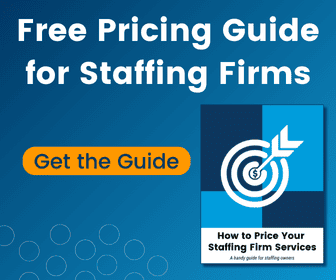Four Key Components to Financial Sustainability

Last time updated: October 23, 2025

What is Financial Sustainability?
At Advance, we define financial sustainability as the ability to start, grow and maintain your staffing business with short- and long-term financial stability. It is amazing how many otherwise savvy staffing operators rely solely on their sales or HR skills to grow their business, and don’t really understand where they are or where they’re headed.
While temporary staffing entrepreneurs give a variety of reasons for starting their own venture – being their own boss, the satisfaction of getting people jobs, fulfilling a need in the marketplace – you won’t be in business long without healthy profits and sustainable growth.
Why Financial Sustainability Is Critical for Staffing Firms in 2025
The economy may be uncertain, but opportunity is still out there for those who are financially prepared to seize it. With ongoing pressures from rising labor costs, delayed payments, and shifting demand, staffing firms need a long-term financial strategy to weather the storm and come out stronger.
Below, we break down what financial sustainability means for staffing firms in 2025—and how you can build it into every aspect of your operation.
Common Financial Pitfalls That Undermine Staffing Firm Growth
Even high-performing staffing firms can fall into traps that limit financial growth:
- Over-reliance on a single funding source (such as a bank line or credit card) can leave you vulnerable to policy shifts or sudden restrictions.
- Poor cash flow forecasting can lead to funding gaps—particularly when payroll hits before client receivables.
- Lack of operating reserves means even a single lost client or late payment can jeopardize your ability to meet financial obligations.
Sustainable firms plan ahead and diversify their resources to reduce these risks.
1. Access to Capital
Trust us on this one, it takes money to make money, and you’ll need a lot of it to run a successful staffing business. Typically, you’ll need initial startup capital to get your staffing firm up and running, ongoing working capital to maintain your day-to-day operations and investment capital to put back into your company and support growth.
To access this capital, you can either self-finance (if your staffing firm is financially sustainable), fund through equity infusion (if you have the money to front the operations yourself), take a loan out at a bank (the most traditional form of lending) or work with a specialty finance agency (yep, that’s us).
Cash Flow Forecasting: A Practical Guide for Staffing Leaders
Great staffing firms don’t just watch cash—they forecast it. Here’s how:
- Forecast weekly or biweekly, not just monthly, to catch potential issues early.
- Align payroll schedules with expected receivables to avoid cash crunches
- Use tools like rolling 13-week cash flow models and sensitivity analysis to anticipate and plan for different scenarios.
This level of visibility gives you the confidence to grow without taking unnecessary financial risks.
Diversifying Your Funding Sources: What Are Your Options?
Relying on a single source of funding is risky. Smart firms diversify with a mix of:
- Bank lines of credit (good rates, but harder to qualify for)
- Payroll funding (flexible and aligned with staffing cash flow)
- Equity capital (for long-term strategic investment)
Diversification gives you better negotiating power, improved cash flow management, and protection during economic shifts. Check out our Staffing Firm Guide to Financing for more information.
Building and Managing Financial Reserves: How Much Is Enough?
Operating reserves are your buffer against uncertainty. Aim to keep:
- 1–3 months of operating expenses in liquid reserves.
- Adjust reserve goals based on seasonality, client concentration, and vertical risk.
- Use surpluses from strong quarters to build reserves before expanding your overhead or hiring new team members.
Your reserves give you agility, peace of mind, and options when opportunity strikes.
2. Profitability
When it comes to profitability, balance counts (and there can be negatives on each side). If your profitability is too low, it may have a negative impact on your cash flow and increase stress throughout your organization. Low profits leave no room for revenue or expense fluctuations and limit your ability to reinvest, which can ultimately compromise your financial sustainability.
On the other side of the token, if your profitability is too high (yes, there is such a thing) it may open you up to undercutting by lower-priced competitors, especially MSPs. Sustained undercutting could lead to destructive price wars in the market and contribute to overall financial instability.
Strategic Budgeting for Sustainable Staffing Operations
Budgeting isn’t just about tracking expenses—it’s about aligning your resources with your goals.
- Separate fixed vs. variable costs so you can stay lean during downturns.
- Plan for growth investments in tech, marketing, and talent.
- Sync budgeting cycles with your cash flow patterns for better real-time decision making.
A forward-thinking budget builds resilience while enabling expansion.
3. Reporting
Taking the time to assess your staffing business is critical to healthy, sustained growth. Creating a plan to review your finances on a regular basis allows you to adjust in time to reverse a negative trend or capture a unique positive opportunity. Whatever your method of secured capital, solid financial reporting will be required to secure increased levels of capital support. And when it’s time to sell your business or grow through mergers and acquisitions, solid financials are a must.
KPIs That Signal Financial Health in Staffing Firms
Focus on tracking KPIs that offer real insight into performance:
-
- DSO (Days Sales Outstanding) – Measures how quickly clients pay.
- Gross Margin – Indicates profitability of placements.
- Net Cash Position – Shows your liquidity on a weekly basis.
- Non-financial KPIs like fill rate and client churn are early warning signs of revenue shifts.
4. Planning
“If you don’t know where you are going, you’ll end up someplace else.” – Yogi Berra
It can be surprisingly easy to stray from your set path to sustainable growth if you do not have your own personal business plan to keep you on course. Your financial planning should be flexible enough to allow for market changes and unexpected opportunities, but strong enough to keep you from veering into dangerous, unsustainable territory.
Governance & Accountability: Who Owns Financial Strategy?
Financial sustainability is a team sport. Ownership and accountability should be clearly defined:
- Executive leadership sets the vision and performance benchmarks.
- Finance teams track and report on progress.
- Owners or founders ensure strategy aligns with long-term goals.
Use tools like scorecards, quarterly check-ins, and cash flow reviews to drive consistency and accountability.
ROI of Financial Sustainability: What’s the Payoff?
Being financially sustainable isn’t just responsible—it’s profitable. It allows you to secure better financing terms and reduce cost of capital, improve your odds of scaling or acquiring other firms, and build a reputation that attracts better clients, partners, and talent.
Financial sustainability gives you leverage and long-term value.
Action Steps
For the long-term financial health of your staffing business, take these Action Steps today:
- Review your current and future capital needs and determine how you will address your anticipated growth
- Analyze and work to balance your profitability
- Assess and improve your reporting and planning capabilities
- Evaluate and understand the purchasing processes of your customers and key prospects
Financial Sustainability FAQs: Answers for Staffing Leaders
How much cash reserve should I hold?
Aim for 1–3 months of operating expenses, adjusted based on your industry and client base.
What’s the best way to forecast cash flow in a staffing model?
Use a rolling 13-week cash flow model updated weekly, factoring in payroll cycles and client payment terms.
Is it better to self-fund or partner with a payroll funding provider?
It depends on your scale and needs. Self-funding offers control; payroll funding offers flexibility and growth support without debt.
Up Next















